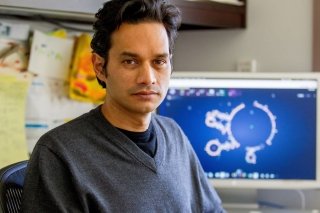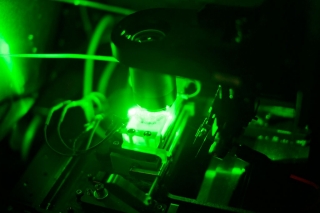Researchers at the Stanford University School of Medicine are releasing a new version of a
The goal in coming months is for Eterna Medicine players to design a molecule that could help spur the development of a new tuberculosis test.

Two Eterna players study a screen showing an RNA molecule designed using the Eterna Medicine computer game. Above is the display output from a custom-built laser microscope for examining the thousands of RNA molecules designed by players. Each green dot represents a different player-generated design. Charlie Wilkes
Tuberculosis infects a third of the world’s population and kills about 1.5 million each year. Yet health organizations lack a
Like a previous iteration of the Eterna game, the new version challenges players to build molecules of RNA with increasingly
RNA is DNA’s inventive cousin. DNA molecules form the standard
Eterna’s
Games with real-life consequences

Rhiju Das says a game like Eterna Medicine could someday enable citizen-scientists to invent their own pharmaceuticals. Norbert von der Groeben
Now Das has set a new challenge in front of them: design a molecule that could help save the lives of millions of people.
Recently, assistant professor of medicine Purvesh Khatri, PhD, and his team came up with a test that can accurately diagnose TB from a simple blood sample. The test looks at the expression levels of three different genes. Cells «express» genes when the cell transcribes a gene into a length of RNA.
In the Khatri lab’s TB test, when the three genes are expressed in certain proportions, doctors know the patient has TB. But how to calculate those proportions in a simple test on a stick — like a pregnancy test — is the challenge. To do so, Das said, they need a molecule that can calculate the proportions of three molecules. Right now, there’s no single molecule that can make that calculation.
But Das said the Eterna game, powered by the minds of thousands of players, can theoretically create a molecule capable of such a calculation. His hope is to get tens of thousands of designs, of which perhaps a thousand may have potential. Das’ lab will then test all of these molecules to see how well they work in the lab. If successful, a subset of 10 to 20 molecules will be tested to see which work best in a real
Said Das, «Eterna Medicine is a little different from the original Eterna because we are trying to recruit people to make something with an eventual
How can a molecule solve an equation?

A slide carrying an array of RNA molecules designed by Eterna players is placed under a special laser microscope designed and built by the labs of Das and Will Greenleaf at the School of Medicine. Charlie Wilkes
The OpenTB molecule will assume different shapes depending on the proportions of the three kinds of
For Das’ plan to work, shape 1 also must be able to bind a fluorescent tag, while shape 2 must not bind the tag. So individual molecules with shape 1 would emit light and those with shape 2 would not.
By measuring the brightness of the light, said Das, you can calculate what proportion of Eterna molecules have folded into shape 1, revealing the proportion of RNAs A and B relative to C. If the light is above a certain threshold of brightness, you know the patient has active tuberculosis.
New paradigm in biological research
Khatri said the idea for using a TB test came about when he and Das were seated together at a conference having dinner. They got to talking, he said, and realized that the TB test might be a perfect challenge for Eterna players. But Das told him that anything more complicated than three or four genes would involve so many possible configurations, it would be almost impossible to solve.
«I love this idea because it changes the biological research paradigm," Khatri said. «If successful, it would allow us to say, ‘We can use publicly available data — ultimately provided by patients themselves — to find a diagnostic signature of one of the biggest killers of mankind. And then we can engage the public to design molecules that can help deploy that test to help other patients using a video game platform.’»
Source: http://med.stanford.edu/news/all-news/2016/05/researchers-release-video-game-to-help-build-better-tb...


